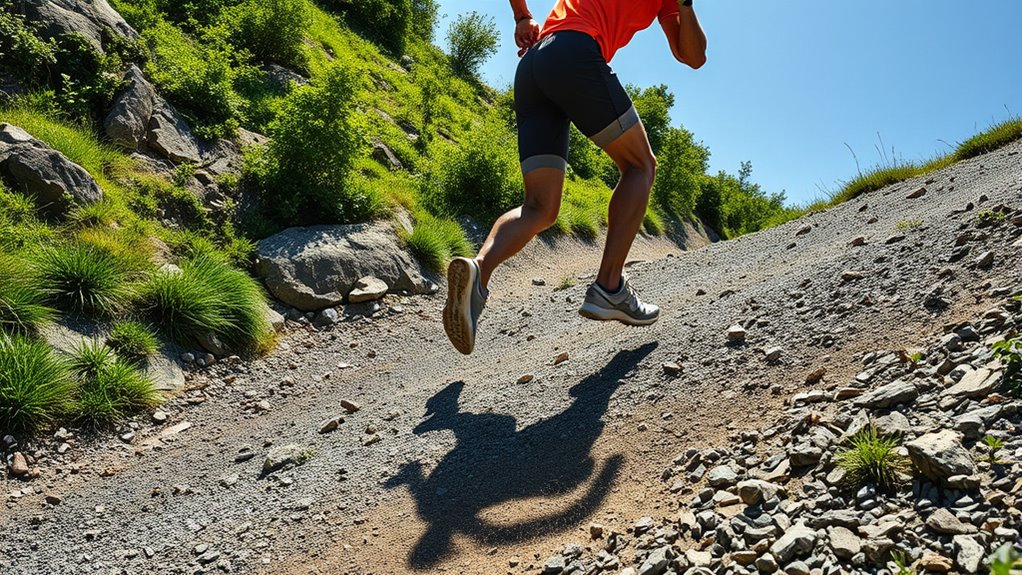To master hill running, focus on adjusting your posture, foot strike, and breathing. Lean slightly forward from your hips on uphill climbs, landing softly on midfoot or forefoot to reduce impact. Use deep, rhythmic diaphragmatic breaths to stay relaxed and maintain stamina. For downhill, stay controlled with a slight lean back, quick steps, and relaxed muscles. Fine-tuning these techniques helps you conquer slopes efficiently—exploring more will reveal how to optimize each motion for maximum performance.
Key Takeaways
- Uphill running involves a slight forward lean, deep diaphragmatic breathing, and midfoot or forefoot strike for efficiency.
- Engaging the core and maintaining proper posture helps conserve energy and enhances power transfer uphill.
- Breathing rhythm, such as inhaling for three steps and exhaling for two, supports sustained effort during steep ascents.
- Downhill running benefits from a relaxed, midfoot strike, controlled steps, and slight body lean to absorb impact and maintain balance.
- Adjusting foot strike and body position reduces impact stress and energy waste on both uphill and downhill terrains.

Running uphill challenges your muscles and alters your mechanics, making it essential to understand how to adapt effectively. When tackling steep inclines, your breathing techniques become a crucial part of maintaining endurance and efficiency. You’ll want to focus on deep, rhythmic breaths that fill your lungs fully, helping to supply oxygen to your working muscles and prevent fatigue. Practice diaphragmatic breathing before your runs so it becomes second nature on steep climbs. This approach not only boosts your oxygen intake but also helps you stay calm and focused as the terrain becomes more demanding. Additionally, your foot strike pattern needs adjustments when running uphill. Instead of landing heavily on your heels, aim for a midfoot or forefoot strike to better absorb shock and propel you forward. This shift reduces the braking force that heel striking can cause and allows for a more natural, energy-efficient stride. Keep your steps quick and light, minimizing the vertical bounce and conserving energy over longer ascents.
As you ascend, lean slightly forward from your hips, keeping your body aligned and centered over your feet. This position helps leverage gravity and improves your power transfer through your legs. Maintain a steady, controlled pace rather than rushing up the hill, so your breathing remains consistent and your foot strike pattern stays smooth. Focus on engaging your core to stabilize your body and prevent unnecessary wobbling, which can waste energy. Remember, it’s better to slow down slightly and maintain proper form than to push too hard and risk fatigue or injury. The key to effective hill running lies in your ability to adapt your breathing and foot strike patterns to the terrain, making each step deliberate and efficient. Developing the right running form can significantly improve your performance and reduce injury risk during uphill segments.
As you become more experienced, experiment with breathing rhythms like inhaling for three steps and exhaling for two, to find what helps you sustain effort. Keep in mind that your foot strike should remain relaxed; stiff landings waste energy and increase impact stress. By consciously adjusting your technique, you’ll find it easier to maintain momentum and reduce fatigue during uphill segments. Properly managing your breathing and foot strike patterns unlocks a more efficient running style, helping you conquer hills with confidence. Over time, these adaptations become second nature, allowing you to focus on your form and enjoy the challenge of hill running rather than feeling overwhelmed by the terrain.
Frequently Asked Questions
How Can I Prevent Injuries While Running Uphill and Downhill?
To prevent injuries while running uphill and downhill, make sure you wear proper footwear with good grip and support. Focus on maintaining core stability to keep your body balanced and reduce strain on your muscles and joints. Use controlled, deliberate strides to avoid overexertion and listen to your body. Incorporating strength training and stretching can also help build resilience and prevent common running injuries on varied terrains.
What Gear Is Best for Hill Running?
For hill running, you want gear selection that boosts stability and traction. Opt for trail running shoes with good grip and cushioned soles to handle varied terrain. Wear moisture-wicking clothing to stay dry, and consider lightweight, breathable layers for temperature changes. Equipment tips include bringing a hydration pack and using trekking poles on steep inclines. This gear helps you stay safe, comfortable, and efficient during challenging uphill and downhill runs.
How Should I Adjust My Pace on Steep Inclines?
When facing steep inclines, you should slow down to maintain form and conserve energy. Use pacing strategies like short, quick steps and lean slightly forward to optimize biomechanical adjustments. Focus on controlled breathing and engaging your core to stay balanced. Remember, it’s better to reduce your pace and maintain efficiency rather than pushing too hard and risking injury or fatigue. Adjust your effort according to the incline’s steepness for a sustainable climb.
Are There Specific Training Techniques for Downhill Running?
You can improve your downhill running by practicing specific training techniques focused on trail technique and downhill efficiency. Instead of fearing steep descents, learn to lean slightly forward, keep your knees flexed, and use quick, light steps. Incorporate downhill drills into your routine, such as controlled descents on varied terrain, to build confidence and strength. This approach helps prevent injury and makes downhill running feel more natural and enjoyable.
How Does Hill Running Improve Overall Running Performance?
Hill running boosts your overall performance by enhancing terrain adaptation and power development. When you tackle inclines and declines, you strengthen muscles, improve balance, and increase your stamina. This varied terrain challenges your body, making you more efficient on flat surfaces. As you progress, you’ll notice better endurance, faster pace, and increased strength, all of which translate to improved running performance across different terrains.
Conclusion
Embrace hill running like a mountain climber scaling peaks—each step a deliberate brushstroke on your adventure canvas. Whether you’re conquering steep ascents or gliding down with the wind, remember that your mechanics are the compass guiding your journey. With every stride, you’re forging strength and resilience, turning rugged terrain into a symphony of movement. So lace up, breathe in the wild spirit, and let the hills transform you into a fearless explorer of your own limits.









